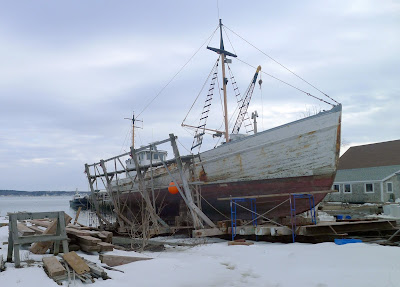Super-simplified paintings may intrigue at first, but do they have enough information to satisfy over time?
 |
| Snow at higher elevations, by Carol L. Douglas |
Yesterday we let the software engineer out of his cage. He traveled down to Pecos National Historical Park with us. He could get a signal enabling him to work. Meanwhile, we painted a snow squall approaching across the Sangre de Cristo mountains. (We’re limited to satellite here on the ranch and a tethered hotspot is faster.)
As is true on the ocean, the sight-lines in the west are extended. You have hours to watch weather unfold. It made for great painting for us, and a nice work setting for him.
A friend once told me, “I’d never date an engineer; they’re too boring.” I’ve found exactly the opposite to be true. This one has an undergraduate arts degree and is a serious musician as well as being a programmer. When he talks about aesthetics, I listen.
 |
| An abandoned farmstead in the Sangre de Cristo Mountains. |
We took him for a brief walk through a small, abandoned farmstead with log and stone barns. It was where I’d spent
most of my time during Santa Fe Plein Air Fiesta last April. The difficulty, I’d found, was in the surfaces, which are textured and edgy and needed more definition than my usual painting style. How could I paint them convincingly without being too detailed?
“Alla primapainting applies a low-pass filter over everything,” he told me. “You need a way to convey high-frequency information in some places.” Huh?
Think about the sound of clapping. It’s impulsive and unexpected. If you were to look at a graph of it, you would see a spike. That’s what they call a high-frequency sound, and it’s exactly the same as a line, a dot, or an edge in your painting—in other words, it’s a big, sudden, value shift, packed with information. It gets your attention. It’s the opposite of low-frequency sounds, which are more like the hum of your dishwasher in the background.
 |
| Our office on the road. My trusty Prius is not up to this terrain. (Photo courtesy of Douglas Perot) |
There are low-frequency passages in painting, too. A grey sky is an extreme example. Nothing much changes there. When you save a photo at too low a resolution and it gets blurry, it’s essentially been subjected to a low-pass filter.
When your teacher tells you, “focus on big shapes,” or “ignore the detail,” he or she is telling you to apply a low-pass filter to your painting. In general, that’s good advice—within limits.
 |
| And then there was snow, and a gravel road up a mountain ridge. (Photo courtesy of Douglas Perot) |
In photography, those blurry, low-resolution photos may intrigue at first glance, but they aren’t that satisfying over time. In the long run, that may be true of paintings as well.
The trick, I think, is to vary high information passages with super-simplified ones. It’s a good goal but it’s not always possible in plein air painting, where you often have to quit before you think you’re finished.
 |
| Horno in the snow, by Carol L. Douglas. I haven’t looked out yet to see how much stuck. |
And that was exactly what happened to us. One minute, it was dark and cold, and the next, snow was swirling everywhere, obscuring our view. We slipped up the road back to the ranch. I’m hoping for snow-cover to last through today. If it doesn’t, I’m sure we’ll find something to paint.






